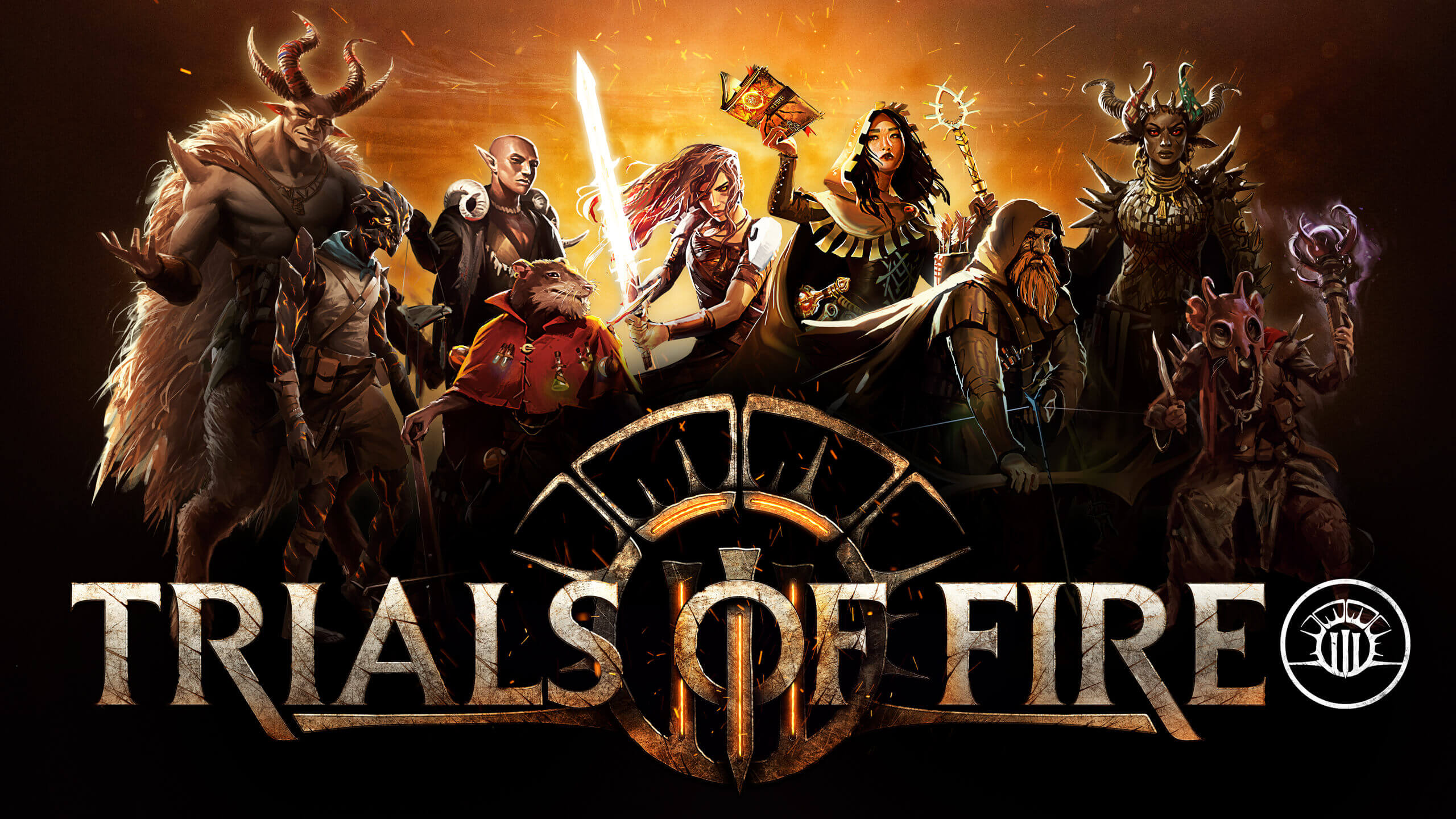Trials of Fire is a tactical deckbuilding roguelite, developed and published by Whatboy Games. Choose the three heroes and go on a quest across a post-cataclysmic wasteland.
Choosing your adventure
Before jumping into our adventure, we are given several choices. These range from the kind of quest we want to start with, to the heroes who’ll accompany us. Each adventurer also comes with a unique passive ability, which allows for many combinations and builds.
We start with only three party members. However, throughout Trials of Fire there’ll be tasks, completing which will unlock alternative companions. The exact things we must do can be viewed at any time in the hero selection menu.
This same menu also allows us to customize the length and the difficulty of our journey. In addition, right before our quest begins, we can modify, to some extent, the heroes’ starting gear.
Except for the main campaign and the lore quests, there are also some additional challenges. Those allow you to test your skills and compete on the leaderboard.
Traveling
As we finish the preparations, the time comes for us to dive into the Trials of Fire’s vast procedurally generated world. The exploration is straightforward: we travel across the wasteland and search the various structures, like towns and ruins. An arrow on the screen always points towards our destination, where a boss fight awaits.
Keep in mind, though, that the longer we take to complete the objective, the more our morale will decrease. That’s not to say that you shouldn’t be exploring. There are many side quests offered at points of interest – as well as items, supplies and experience for our characters. However, Trials of Fire makes it clear that our heroes’ priority is still helping the people – not searching for better gear.
In addition to morale, there’s another thing affecting our world map exploration: stamina. The more we move around, the more it decreases. Eventually we’ll have to stop and rest, which’ll require supplies. Keeping both the stamina and the morale high gives us various bonuses, like better chance to find loot or more health.
When we enter a point of interest – be it ruins, village, or some other place – we get a little flavor event. Those can have multiple outcomes, too – including regular combat. Sometimes, we might find some obsidian (money). At other times, we have X% to succeed at some task, and Y% to take damage.
Overall, the exploration feels good. There’s a nice balance between having a clear objective – and some additional tasks to complete along the way.
Inventory, Deck Management and Resting
While on the world map, we can access our party inventory and level up our heroes. A good set of items gives plenty of bonuses, but we need to be wary of what we equip. Improving some character’s armor, we add cards to their deck – making it harder to get other cards we might want.
Except for the equipment, each hero also has a unique starting class deck. These help differentiate the characters and allow for different specs. Though, I wish there was a way to expand those, to offer a greater variety.
Each item type provides a character with a set amount of skills and bonuses. Those include armor, more cards, as well as quality. The latter affects our redraw chances, which I’ll explain later.
Our equipment is the main way for us to manage our deck. Each hero comes with its own set, but every level, we can choose one of four cards to replace one of theirs. The characters also have different equipment slots, allowing for additional variety in specialization.
Most heroes can specialize in several things at once. The warrior will gravitate more towards physical stuff. However, the elementalist will have both physical and magical abilities; this flexibility allows them to specialize in ranged combat using supportive spells – or in melee, hacking and slashing their enemies with their enchanted sword.
This allows for many combinations. Already have enough melee characters? Give one of them a bow. Need to be close to your enemies? Let your archer have a go with the sword. There are plenty of team building options.
During rest, we also get to make several choices. We can simply relax, healing and restoring stamina – or we can do some card management. We can hone items, removing a skill from them; meditate to get rid of some of the above-mentioned class cards; or upgrade items with bonuses, like more damage. In addition, we can also just heal injuries.
I really like having a myriad choices on how to customize the heroes. This gives a lot of flexibility with their specialization, despite their starting class decks.
Combat
When we encounter enemies, the game throws us onto a hex map, where we and our foes will take turns. Generally, our party gets a shared mana pool, called willpower – starting at zero. There are several ways we can build it using the movement cards, to buff party members and improve willpower gains.
Another way to control our willpower gains is to discard cards. This also has other uses: except gaining willpower, a character to whom the card belonged to could move up to two tiles, or redraw. The latter is limited by our quality, which I mentioned before. For example, we could only redraw three times per battle. Also worth mentioning is that at the end of your turn you can only have a maximum of one card per character.
The combat is smooth, and the little animations feature nice details. We also have many opportunities to affect which way the battle will go. We can cripple enemies, so that they can’t move, or put various debuffs on them – like burning, which deals damage every turn. Some other options include dragging enemies towards yourself – useful for our frontline fighters.
There are also obstacles on the map, blocking our line of sight. This can be problematic for our wizards and archers, as they won’t be able to damage enemies, without moving.
If one of your heroes dies in combat, it’s not the end for them. They return at the end of the battle, though with injuries. There are two ways to heal those. You can rest – but you’ll need herbs that are semi-rare; or you can try to defeat the boss and if your hero falls in this fight – their injury is gone.
When we run out of cards, our deck is reshuffled, and we gain exhaustion cards. These have no effect other than taking up space.
I believe that combat is the strongest point in Trials of Fire. There are many ways to approach fighting, covering everything from heroes – to items.
The Bad
Sadly, Trials of Fire isn’t without flaws. One negative thing is the lack of variety in bosses. While these are set in the story mode, after a few plays in the procedural world, you may end up running into the same ones multiple times. A big shame, as – despite being enjoyable – these fights did end up feeling repetitive.
Another thing I see as negative is that there’s almost no reason to keep a thin deck. Many other deckbuilding games give you an option to keep either a small or a large number of cards. Here, the latter always seems like a better choice. This is just to avoid stacking in exhaustion, which can be really prevalent during boss fights.
That said, adding items just to have more abilities isn’t the best idea. You have to consider your overall strategy and the team’s synergy – so bigger doesn’t necessarily mean better.
Some might also dislike the lack of an engaging narrative. The story is told in short segments during exploration. It often feels disjointed, as the NPCs explain your task, without any information about the world itself. As someone who likes a good tale, I didn’t find much to be invested in. Still, the other aspects of the game completely outshine this issue – at least for me.
Conclusion
Trials of Fire is a strong game as far as deckbuilders go – despite its flaws. The exploration feels good, the art is nice, and the soundtrack builds a fitting atmosphere. The combat is fluid, versatile and is its strongest aspect – while the variety of characters allows for great replayability, beyond its procedurally generated world. A game worth giving a try.







